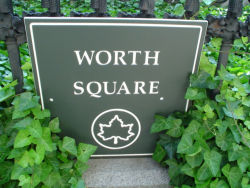Worth Square
General Worth Square
This small square marks the grave of General William Jenkins Worth (1794-1849). Born to Quaker parents in Hudson, New York, Worth worked briefly at a store in Hudson before moving to Albany to pursue a mercantile career. With the outbreak of the War of 1812 (1812-1815), he broke with his family’s pacifist beliefs and enlisted in the Army. He distinguished himself as an aide-de-camp to Generals Morgan Lewis and Winfield “Old Fuss and Feathers” Scott. Worth was promoted for battlefield valor at Chippewa (July 5, 1814) and Lundy’s Lane (July 25) near Niagara Falls. Although he was not a graduate of the United States Military Academy at West Point, he served as its fourth Commandant of Cadets from 1820 to 1828. Returning to battlefield service in 1841, Worth fought in the last stages of the Second Seminole War and was promoted to the rank of general in 1842. Though a victorious commander in Florida, Worth urged that the Seminoles be allowed to live in peace and maintain certain territorial rights.
After a short stint fighting on the Texas frontier, Worth was transferred back under General Scott’s command for the Mexican War (1846-1848). He commanded a division at the siege of Vera Cruz (March 9-29, 1847), the battles of Cerro Gordo (April 18), Contreras and Churubusco (August 19-20), and Molino del Rey (September 8). He also participated in the seizure of the San Cosme Gate during the American army’s final assault on Mexico City (September 13-14). A lengthy dispute involving charges of intrigue against General Scott ended in his successful acquittal by a court of inquiry in 1848, and Worth was re-appointed to command post of the Department of Texas. He died of cholera in San Antonio the following year, and his body was returned to the state of his birth for burial.
The City originally leased this site at the intersection of Broadway, Fifth Avenue, West 24th and West 25th Street in the Flatiron district of Manhattan to the United States Government for $1.00 as part of an 1807 land deal. It reverted to City ownership in 1824. Parks designated it as a public park in 1847. Worth had been temporarily interred at Greenwood Cemetery in Brooklyn while the site was chosen and developed for his permanent interment. He was reburied here on Evacuation Day, November 25, 1857, the anniversary of the British departure from the American colonies. The burial followed an elaborate processional which included 6,500 soldiers. A relic box was placed in the cornerstone. Mayor Fernando Wood delivered the principal oration.
James Goodwin Batterson (1823-1901) designed the 51-foot granite Worth Monument. He was the founder of Travelers Insurance Company and one of the designers of the United States Capitol and Library of Congress in Washington, D.C., as well as the New York State Capitol in Albany. The monument’s central decorative bands are inscribed with battle sites significant in Worth’s career and attached to its front is a bronze equestrian relief of Worth. The four corner granite piers once held decorative lampposts, but they now support an elaborate ornamental cast-iron fence whose pickets are replicas of Worth’s Congressional Sword of Honor. The north side fence was removed around 1940 to accommodate an above ground utility shed which services the water supply system pipes beneath the monument.
In 1994, Municipal Art Society President Kent Barwick, Preservationist Henry Hope Reed, and Parks Commissioner Henry Stern commemorated the 200th anniversary of Worth’s birth and laid a wreath at the site. In 1995, the monument underwent an extensive restoration funded mainly by the Paul & Klara Porzelt Foundation and Commander, United States Navy (Retired) James A. Woodruff Jr, Worth’s great-great grandson. He and his family have endowed the maintenance of the monument and surrounding planting bed through the Municipal Art Society’s Adopt-A-Monument Program.
The Worth Monument is the second oldest monument in New York – the oldest being the 1856 George Washington equestrian monument at the southern end of Union Square. It also remains one of only two New York monuments that also serves as a mausoleum. The other is Grant’s Tomb in Harlem.
Check out your park's Vital Signs
Clean & Safe
Green & Resilient
Empowered & Engaged Users
Share your feedback or learn more about how this park is part of a
Vital Park System




